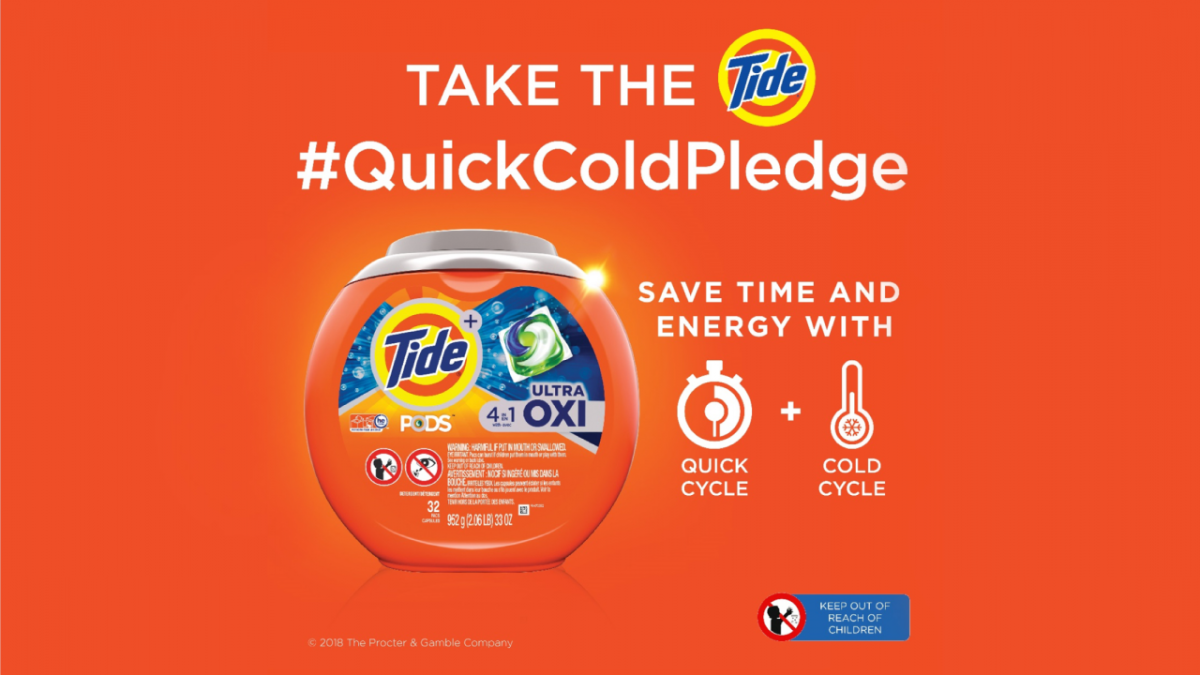High-performing Surfactants May Mean Even Better Cold-water Cleaning—and Reduced Household Energy Consumption by Encouraging Eco-friendly Consumer Habits

On June 11, 2018, Procter & Gamble (P&G) announced presentations given on new research into sustainability innovations for its Tide® laundry detergent. The presentations discussed the potential for improved cleaning performance in cold water conditions with detergents containing a patented branched surfactant. While machine washing in cold water can reduce a household’s energy footprint, detergents may not perform as well on this setting, which can compel consumers to use more energy and water to compensate.
Tide Research Fellow Phillip Vinson, PhD, and Tide Senior Scientist Patrick Stenger, PhD, gave presentations at the 2018 American Oil Chemists Society Annual Meeting and the 22nd International Symposium on Surfactants in Solution, respectively.
“Reducing greenhouse gas emissions is a top sustainability priority for P&G, and enabling lower energy washing is an important part of that,” said Mary Begovic Johnson, Tide Senior Scientific Communications Manager. “We’re committed to designing detergents that deliver a superior Tide clean in cold water conditions so consumers don’t have to choose between clean clothes and being environmentally conscious.”
Given that 80% of the energy consumed during the wash cycle is used to heat water, cold water cleaning of laundry can reduce a household’s carbon footprint. But when cold water cleaning is ineffective, it presents a variety of sustainability issues. Rewashing textiles isn’t a solution— it just doubles the energy and water usage per load. Additionally, compensating behaviors like using more detergent or additives like bleach just increase raw materials usage and carbon emissions. The alternative, washing in warm or hot water, can increase household emissions by more than 300 pounds of carbon dioxide, per year. Finally, poor detergent performance reduces textiles’ lifespan. In the United States 10.5 million tons of clothing and textiles end up in landfills every year—and color fading, stains and overall dinginess are all contributing factors to clothes being discarded.
“Cleaning in cold water presents significant challenges. Common food greases can harden and become adhesive when they’re washed in cold water. With synthetic fibers like polyester, which make up nearly two-thirds of the world’s textiles, it’s even worse. Because they are hydrophobic, synthetic fibers stick to food greases, making them even more difficult to remove in cold water,” said P&G presenters Phillip Vinson and Patrick Stenger. “Precise and sophisticated design of our surfactant molecules, down to the specific carbon chain lengths and positioning of branches on that chain, shows potential for impressive stain-fighting power in different types of washing machines and settings. And these branched surfactants are highly biodegradable, which is a definite bonus.”
In the presentation, P&G discussed the process behind transforming paraffins into high-purity olefins that can be further modified into highly branched 2-alkyl alcohols (2-AA) rich in C15 isomers. Using ISALCHEM® isomeric primary alcohols as reference points, 2-AAs with high levels of C15 isomers were shown to have the lowest interfacial tension, meaning they more readily disperse and clean when in contact with water and stains. Additionally, detergent prototypes rich in C15 2-AA demonstrated the most effectiveness in terms of stain removal and maintenance of whiteness based on complex modeling and physical testing. In results from full-scale testing conducted in a front-loading washing machine at 15 and 40 degrees Celsius, the C15 rich 2-AA was significantly more effective at removal of four types of food greases at both temperatures and significantly narrowed the gap in food grease removal typically seen between cold versus warm water conditions, compared to surfactants currently used in detergents. Additionally, the C15-rich 2-AA variants passed the standard tests for biodegradability as described by the Organization for Economic Cooperation and Development (OECD).
These research and development efforts into C15 rich 2-AA surfactants are enabling improved sustainability in laundry washing by reducing energy consumption while delivering superior detergent performance in cold water conditions. In addition, P&G shared developments on alternatives to petrochemical-derived surfactants, based on bio-materials and recycled plastics, for Tide® and other P&G brands. These efforts are key to P&G’s commitment to meeting the sustainable surfactant needs of the future.
ABOUT PROCTER & GAMBLE
P&G serves consumers around the world with one of the strongest portfolios of trusted, quality, leadership brands, including Always®, Ambi Pur®, Ariel®, Bounty®, Charmin®, Crest®, Dawn®, Downy®, Fairy®, Febreze®, Gain®, Gillette®, Head & Shoulders®, Lenor®, Olay®, Oral-B®, Pampers®, Pantene®, SK-II®, Tide®, Vicks®, and Whisper®. The P&G community includes operations in approximately 70 countries worldwide. Please visit http://www.pg.com for the latest news about P&G and its brands.
Contact
Procter & Gamble
Mary Begovic Johnson, MS, 513-627-6856
Johnson.mb.3@pg.com

